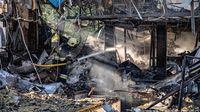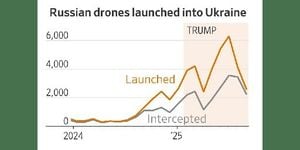As the Russia-Ukraine war grinds into its fourth year, the debate over who bears responsibility and what steps could end the conflict has become increasingly heated—especially among U.S. political leaders. On September 13, 2025, former President Donald Trump reignited controversy with a series of social media posts and statements, blaming President Joe Biden and Ukrainian President Volodymyr Zelenskyy for the ongoing war, while criticizing NATO’s response and outlining new conditions for U.S. sanctions against Russia. The remarks triggered swift backlash from fellow Republicans, renewed scrutiny of NATO’s internal divisions, and drew attention to the growing financial and human costs of the war in Ukraine.
Rep. Don Bacon (R-Neb.), a frequent critic of Trump’s stance on Eastern Europe, did not mince words in his response. In a Saturday morning post on X, Bacon challenged Trump’s assertion that the war was solely the responsibility of Biden and Zelenskyy, calling such a claim “morally blind and factually wrong.” Bacon wrote, “Mr President, Putin is the one who is the invader. And, now this war is on your watch and you’ll be judged in the history books in the decades to come by your actions or lack thereof,” according to The Hill. Bacon’s comments reflect a growing unease among some Republicans about the party’s positioning on Ukraine, as well as frustration over Trump’s repeated reluctance to place primary blame on Russian President Vladimir Putin for launching the invasion.
Trump, meanwhile, doubled down on his position. In a letter posted to Truth Social, he argued that the war would end if all NATO countries stopped buying oil from Russia and imposed tariffs of 50% to 100% on China for its purchases of Russian petroleum. “I am ready to do major Sanctions on Russia when all NATO Nations have agreed, and started, to do the same thing, and when all NATO Nations STOP BUYING OIL FROM RUSSIA,” Trump wrote, as reported by DW. He further criticized the alliance’s commitment to Ukraine, stating, “NATO’S commitment to WIN has been far less than 100 percent, and the purchase of Russian Oil, by some, has been shocking! It greatly weakens your negotiating position, and bargaining power, over Russia.”
The economic ties between Russia and several NATO members have become a flashpoint. Since 2023, Turkey has been the third-largest buyer of Russian oil after China and India, with Hungary and Slovakia also continuing to import Russian energy products, according to the Centre for Research on Energy and Clean Air. Trump’s criticism of these purchases highlights the rift within the alliance over how best to pressure Moscow. He has threatened secondary sanctions on countries buying Russian oil—including China and India—and has already imposed an additional 25% tariff on Indian goods due to its continued imports of Russian oil.
Trump’s approach has not been limited to rhetoric. During a recent call with finance ministers from the Group of Seven, U.S. Trade Representative Jamieson Greer and Treasury Secretary Scott Bessent urged allies to present a “unified front” to cut off the revenues funding Putin’s war machine, according to Greer’s office. However, Trump has consistently argued that the war would not have started if he were president, writing, “This is not TRUMP’S WAR (it would never have started if I was President!), it is Biden’s and Zelenskyy’s WAR. I am only here to help stop it, and save thousands of Russian and Ukrainian lives (7,118 lives lost last week, alone. CRAZY!).”
Yet, Trump’s refusal to assign responsibility to Putin, who launched the invasion in 2022, remains a contentious issue. In his posts, Trump continued to lay the blame at the feet of Biden and Zelenskyy, a move that has drawn criticism from both sides of the political spectrum. Bacon’s rebuke is emblematic of this divide: “It is [former President] Biden’s and [Ukrainian President Volodymyr] Zelenskyy’s war’ is so morally blind and factually wrong,” he wrote. “Mr President, Putin is the one who is the invader.”
Meanwhile, the war’s toll on Ukraine continues to mount. Ukraine’s Defense Minister Denys Shmyhal announced that the country will need at least $120 billion for defense in 2026, as reported by DW. “The economy of the war demonstrates that if we spend less money than Russia, then we begin paying with our territories and, most importantly, with our lives,” Shmyhal said at an annual conference in Kyiv. Ukraine now spends over a third of its gross domestic product on its army, with daily costs rising to $172 million in 2025, up from $140 million the previous year. Roksolana Pidlasa, head of the parliamentary Budget Committee, emphasized the urgent need for allies to help direct Russian frozen assets to support Ukraine’s defense.
On the ground, the war has seen new developments. The Russian Defense Ministry claimed on September 13 that its troops had captured the village of Novomykolaivka near the Donetsk region, though this has not been confirmed by Ukrainian sources. Observers also reported that Russian forces used a gas pipeline as a tunnel to strengthen their position near the strategic eastern city of Kupiansk, a move that Ukrainian military command downplayed, insisting there was no direct threat to the city.
Elsewhere, the conflict’s spillover effects have become harder for NATO to ignore. On September 13, Romania became the second NATO country to report a Russian drone incursion, after Poland shot down several drones that crossed into its airspace earlier in the week. The Romanian Defense Ministry stated that two F-16 jets were deployed to monitor the border with Ukraine after a drone briefly entered Romanian airspace, though it “did not fly over populated areas and did not pose an imminent threat to the safety of the population.” Polish authorities, meanwhile, closed the airport in Lublin temporarily and deployed aircraft to safeguard their airspace, underscoring the growing anxiety among NATO’s eastern flank.
Amid these tensions, a drone attack caused a fire at an oil production site in Russia’s Bashkortostan region on September 13. The regional governor labeled it a “terrorist attack” but reported limited damage and no casualties. The incident, while not directly linked to the Ukraine front, highlights the broader risks of escalation as the conflict drags on.
As the war shows no signs of abating, the debate over responsibility, strategy, and the path to peace remains as charged as ever. For Ukraine, the costs are measured in lives and billions of dollars. For NATO, the challenge is maintaining unity in the face of economic interests and political discord. And for the United States, the question of leadership—past, present, and future—continues to fuel fierce debate at home and abroad.




